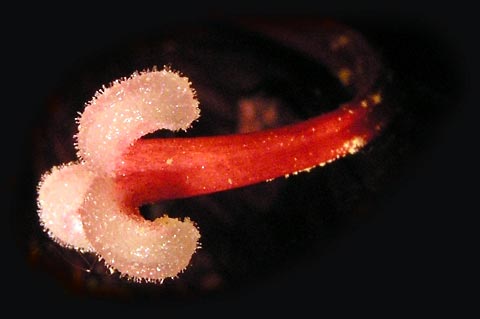Genesis 1:27 ~
"So God created man in his own image, in the image of God he created him; male and female he created them." (King James Version)
INTERPRETATION: God is the origin, creator and cause of masculine and feminine qualities of each created being (matter, plants, animals, and humans) of the universe, as "Pattern #1-Masculinity and Femininity" reveals in the table below:
 Each being category above (matter, plants, animals, humans) contains a range of variation; yet, the extreme ends of the variation spectrum are always and only masculinity and femininity. Variation between the extremes include:
Each being category above (matter, plants, animals, humans) contains a range of variation; yet, the extreme ends of the variation spectrum are always and only masculinity and femininity. Variation between the extremes include:~ Neutrons
~ Hermaphroditic plant, animal, and human types
~ Combination matter and/or plant types
~ Combination plant and/or animal types
~ Combination man and/or woman types
Everything exists through the reciprocal relationship of masculinity and femininity striving to harmonize into the image of God. As the origin, God is the standard for harmony and oneness between masculine and feminine attributes.
Below, we take a closer look at the masculine and feminine trademark imprinted in each created being of the universe (1-matter, 2-plants, 3-animals, 4-humans):
1 - MATTER (Proton and Electron):
The proton is a subatomic particle with a positive electricric charge of +1 elementary charge. In chemistry the number of protons in the nucleus of an atom is known as the atomic number, which determines the chemical element to which the atom belongs. For example, the atomic number of chlorine is 17; this means that each chlorine atom has 17 protons and that all atoms with 17 protons are chlorine atoms. In the atom below, the proton is the yellow particle in the nucleus: The electron is a subatomic particle that carries a negative electrical charge. As shown in the picture above, it is the green particle that orbits an atom's nucleus. Experiments with Crookes tube first demonstrated the particle nature of electrons.
The electron is a subatomic particle that carries a negative electrical charge. As shown in the picture above, it is the green particle that orbits an atom's nucleus. Experiments with Crookes tube first demonstrated the particle nature of electrons.
.
2 - PLANTS (Stamen and Pistil):
The stamen (plural stamina or stamens, from Latin stamen meaning "thread of the warp") is the male organ of a flower. The Greek term is called an androecium. Below is a picture of the stamens of the Amaryllis with prominent anthers carrying pollen:
 .
.
The pistil, either one or more combined, forms a gynoecium (from Ancient Greek gyne, "woman") which is the female reproductive part of a flower. Below is a picture of the Amaryllis style and stigmas: A pistil may consist of a single free carpel, or be formed from a number of carpels that are fused. The pistil itself is formed from the stigma, style, and ovary. A plant ovary (much like an animal ovary) is the part of the pistil which contains ovules. The style is generally referred to as stalk like, without ovules located between the ovary (at the bottom of the pistil) and the stigma (located at the top portion of the pistil). In some plant species styles are not found in the pistils. The stigma is the pollen receptor within the pistil at the top of the pistil. Stigmas may be discretely defined structures or they may be within a region referred to as the stigmatic region.
A pistil may consist of a single free carpel, or be formed from a number of carpels that are fused. The pistil itself is formed from the stigma, style, and ovary. A plant ovary (much like an animal ovary) is the part of the pistil which contains ovules. The style is generally referred to as stalk like, without ovules located between the ovary (at the bottom of the pistil) and the stigma (located at the top portion of the pistil). In some plant species styles are not found in the pistils. The stigma is the pollen receptor within the pistil at the top of the pistil. Stigmas may be discretely defined structures or they may be within a region referred to as the stigmatic region.
3 - ANIMALS (MALE AND FEMALE):
The Male animal. A lion is shown in the picture below:

4 - HUMANS (Man and Woman):
The Man, shown below:

Michelangelo's David is the classical image of youthful male beauty in Western art.
The Woman, shown below: Truth, 1870, by Jules Joseph Lefebvre
Truth, 1870, by Jules Joseph Lefebvre